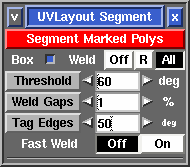User Guide: Segment
From UVLayout Docs
(Difference between revisions)
| Revision as of 10:26, 29 April 2009 (edit) Headus (Talk | contribs) ← Previous diff |
Revision as of 10:47, 29 April 2009 (edit) (undo) Headus (Talk | contribs) Next diff → |
||
| Line 1: | Line 1: | ||
| - | {{:User Guide: Menu}} [[Image:UserGuide-Segment.png|right|]] The '''Segment''' tool is ... | + | {{:User Guide: Menu}} [[Image:UserGuide-Segment.png|right|]] The '''Segment''' tool is used to speed up the flattening of "hard" surface geometry, that is, non-organic shapes like buildings, furniture and other props. |
| - | ; Segment Marked Polys : | + | ; Segment Marked Polys : Click this to detach and drop all marked polys. Each separate object is segmented into a number of shells depending on each polys surface normal. Polys that are facing in a similar direction are kept together, but when the angle is too sharp, they're split apart. |
| - | ; Box : | + | ; Box : Each group of marked polys are boxed |
| ; Weld : | ; Weld : | ||
| Line 9: | Line 9: | ||
| ; Opt : | ; Opt : | ||
| - | ; Threshold : | + | ; Threshold : This angle determines at which point adjoining polys are split apart. Increasing this angle will result in less fragmentation (i.e. fewer shells), but there will be more distortion in the resulting UVs and extra cuts or darts may need to be added. Reducing this angle will increase the fragmentation, and so more time will need to be spent welding them back together. |
| ; Fast Weld : | ; Fast Weld : | ||
Revision as of 10:47, 29 April 2009
|
The Segment tool is used to speed up the flattening of "hard" surface geometry, that is, non-organic shapes like buildings, furniture and other props.
|
